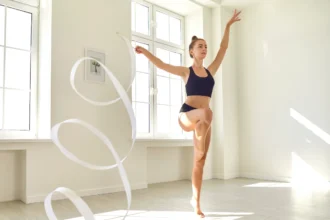Shoulder injuries are one of the most common concerns for athletes, especially gymnasts who perform high-risk exercises that demand strength and mobility. One key to maintaining healthy, strong shoulders is strengthening the rotator cuff. In this article, we will walk you through the best rotator cuff exercises gymnasts use to build and maintain shoulder health.
What is the Rotator Cuff?
The rotator cuff is a group of four muscles and their associated tendons that work together to stabilize and support the shoulder joint:
- Supraspinatus – responsible for lifting the arm to the side.
- Infraspinatus – facilitates the outward rotation of the arm.
- Teres Minor – works alongside the infraspinatus for external rotation.
- Subscapularis – aids in rotating the arm inward.
Together, these muscles help keep the humerus (upper arm bone) properly aligned within the shallow socket of the scapula (shoulder blade). This alignment allows for a full range of motion but also makes the shoulder prone to dislocation if these muscles are weak or overused.
While ligaments and connective tissues help stabilize the shoulder, the muscles around them must also be strong to prevent injuries. Many gymnasts experience shoulder pain or even dislocations due to a weak rotator cuff, making it crucial to include specific exercises to strengthen these muscles.
5 Effective Rotator Cuff Exercises for Gymnasts
If you’ve never focused on strengthening your rotator cuff, incorporating the following exercises into your routine is essential. These exercises are listed in order of intensity, so beginners can start with the easier ones and progress as strength builds. Aim to incorporate them after your general warm-up or at the end of your workout.
1. Lying Lateral Rotations
Start by lying on your side with your legs bent at a 90-degree angle, supporting your head with your lower arm. Keep your torso straight and slightly abduct your scapula (shoulder blades) to stabilize your shoulder. Your top arm should be bent at a 90-degree angle at the elbow, with your upper arm aligned with your body.
From here, slowly rotate your forearm outward, bringing your hand toward the ceiling. Focus on rotating your arm from the shoulder joint, not just the wrist or hand. Keep your elbow stationary by your side during the entire movement. Once your forearm is parallel to the floor, slowly lower it back to the starting position in a controlled manner.
- Tips: Perform each rep slowly, paying attention to both the concentric (lifting) and eccentric (lowering) phases. This helps to build strength and stability through the full range of motion. Start with a light weight such as a 5–10 pound dumbbell or even a water bottle to ensure proper form. Focus on quality over quantity, and only increase weight as you feel comfortable.
- Reps: 15–30 repetitions, depending on the resistance you’re using.
- Sets: 3 sets per arm.
2. Lateral Rotations (Standing)
Stand tall with your feet shoulder-width apart. Hold a light resistance band or cable machine handle in your working hand, keeping your elbow bent at a 90-degree angle and tucked close to your side. Your elbow should be aligned with your torso, with the forearm angled forward and parallel to the floor.
Engage your core and stabilize your scapula (pull your shoulder blade down and in towards your spine). Keeping your elbow fixed by your side, rotate your forearm outward, pulling the band or cable handle away from your body. Stop once your forearm is parallel to the ground and your elbow is still fixed in position.
Control the movement back to the starting position, focusing on maintaining good posture and control over your shoulder and elbow. Avoid pulling with your elbow—allow your rotator cuff muscles to do the work.
- Tips: Perform the exercise slowly and with controlled movements to maximize muscle engagement. Keep your shoulder blades stable and avoid any movement in the elbow. Start with lower resistance to maintain good form.
- Reps: 15–30 repetitions, depending on resistance.
- Sets: 3 sets per arm.
3. Cuban Rotation (Cuban Press)
Start by standing with your feet shoulder-width apart, holding a light dumbbell or resistance band in both hands. Raise your arms so that your upper arms are parallel to the floor and your elbows are bent at 90 degrees, forming a “L” shape with your arms. Your forearms should be perpendicular to the floor.
Rotate your arms backward, externally rotating your shoulders while keeping the upper arms and elbows stationary. Your forearms should stay at a 90-degree angle as you rotate. Keep the movement smooth, and focus on isolating the rotator cuff muscles. Once you reach the maximum rotation, reverse the movement and return to the starting position.
- Tips: Practice the movement with no weight before adding resistance to ensure proper form. As you improve, you can progress to using dumbbells or a resistance band for added challenge.
- Reps: 10–15 repetitions per arm.
- Sets: 3 sets.
4. Cuban Press (Seated Variation)
Sit on a bench with your feet flat on the floor, holding light dumbbells in both hands. Raise your arms to the side, keeping your elbows bent at 90 degrees, so your upper arms are parallel to the ground and your forearms are perpendicular to the floor.
From this position, rotate your forearms backward, keeping your elbows fixed in place. Once you have fully rotated your arms, press the dumbbells overhead by extending your elbows, while maintaining the 90-degree bend in your elbows. Lower the dumbbells back to the starting position, carefully controlling the movement.
This variation incorporates both the Cuban rotation and an overhead press, which provides a more dynamic challenge for the rotator cuff and shoulder muscles.
- Tips: Perform the exercise slowly to ensure proper form, especially as you press the weights overhead. Focus on keeping your shoulder blades stable throughout the movement. Start with light weights and gradually increase resistance as you build strength.
- Reps: 10–15 repetitions.
- Sets: 3 sets.
5. Reverse Cuban Rotation (Standing with Lean)
Stand with your knees slightly bent and lean forward at about a 45-degree angle, keeping your back straight and your core engaged. Hold a light dumbbell or resistance band with both hands, ensuring your elbows are bent at 90 degrees and your forearms are parallel to the floor. Position your elbows in front of your body.
From this position, pull your elbows out to the side, creating a 90-degree angle between your upper arms and forearms. Then, rotate your forearms backward, maintaining the same angle between your upper arms and body. This movement targets the rotator cuff and helps improve scapular stability, which is essential for maintaining proper posture.
- Tips: Keep your back straight and your core tight to avoid unnecessary strain on your lower back. Perform the movement slowly, and focus on proper shoulder engagement to avoid using momentum.
- Reps: 10–15 repetitions per side.
- Sets: 3 sets.
Incorporating these rotator cuff exercises into your workout routine will help strengthen and stabilize your shoulder joints, reducing injury risk and boosting performance in both basic and advanced movements.
Start with lighter weights or resistance and focus on proper technique to maximize the benefits. As you progress, you can increase the intensity by adding more resistance or trying more challenging variations.





